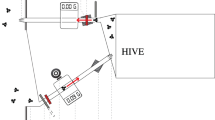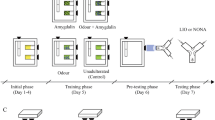Abstract
Honeybees selected for the colony level phenotype of storing large quantities of pollen (pollen hoarding) in the nest exhibit greater walking activity than those selected against pollen hoarding. In this study, we use a simple walking assay to demonstrate that walking activity increases with the proportion of high pollen-hoarding alleles in pure and backcrossed strains of bees (high-strain bees > offspring generated from a high backcross > offspring generated from a low backcross > low-strain bees). The trait is heritable but is not associated with markers linked to three quantitative trait loci (QTL) mapped for their effects on pollen hoarding with demonstrated pleiotropic effects on pollen and nectar foraging and learning behavior. However, locomotion in non-selected bees is correlated with responsiveness to sucrose, a trait that correlates with foraging and learning behavior. We propose that pollen-hoarding behavior involves a syndrome of behavioral traits with complex genetic and regulatory architectures that span sensory sensitivity, foraging behavior, and learning. We propose that locomotor activity is the component of this syndrome and reflects the early maturation of the bees that become pollen foragers.

Similar content being viewed by others
Abbreviations
- QTL:
-
Quantitative trait locus
References
Amdam GV, Norberg K, Page RE (2004) Reproductive ground plan may mediate colony-level selection effects on individual foraging behavior in honeybees. Proc Natl Acad Sci USA 101:11350–11355
Blenau W, Erber J (1998) Behavioral pharmacology of dopamine, serotonin, and putative aminergic ligands in the mushroom bodies of the honeybee (Apis mellifera). Behav Brain Res 96:115–124
Blenau W, Balfanz S, Baumann A (2000) Amtyr 1: characterization of a gene from honeybee (Apis mellifera) brain encoding a functional tyramine receptor. J Neurochem 74:900–908
Calderone NW, Page RE (1988) Genotypic variability in age polyethism and task specialization in the honeybee, Apis mellifera (Hymenoptera: Apidae). Behav Ecol Sociobiol 22:17–25
Calderone NW, Page RE (1991) Evolutionary genetics of division of labor in colonies of the honeybee (Apis mellifera). Am Nat 138:69–92
Calderone NW, Page RE (1992) Effect of interactions among genotypically diverse nestmates on task specialization by foraging honeybees (Apis mellifera). Behav Ecol Sociobiol 30:219–226
Calderone NW, Page RE (1996) Temporal polyethism and behavioural canalization in the honeybee, Apis mellifera. Anim Behav 51:631–643
Erber J, Kloppenburg P, Scheidler A (1993) Neuromodulation by serotonin and octopamine in the honeybee: behavior, neuroanatomy and electrophysiology. Experientia 49:1073–1083
Falconer DS (1981) Introduction to quantitative genetics, 2nd edn. Longman, London
Farris SM, Robinson GE, Fahrback SE (2001) Experience- and age-related outgrowth of intrinsic neurons in the mushroom bodies of the adult worker honeybee. J Neurosci 21:6395–6404
Fewell JH, Page RE (2000) Colony-level selection effects on individual and colony foraging task performance in honeybees, Apis mellifera L. Behav Ecol Sociobiol 48:173–181
Hellmich RL, Kulincevic JM, Rothenbuhler WC (1985) Selection for high and low pollen-hoarding honeybees. J Heredity 76:155–158
Humphries MA, Müller U, Fondrk MK, Page RE Jr (2003a) PKA and PKC content in the honeybee central brain differs in genotypic strains with distinct foraging behavior. J Comp Physiol A 189:555–562
Humphries MA, Mustard JA, Hunter SJ, Mercer A, Ward V, Ebert PR (2003b) Invertebrate D2 type dopamine receptor exhibits age-based plasticity of expression in the mushroom bodies of the honeybee brain. J Neurobiol 55:315–330
Hunt GJ, Page RE (1995) Linkage map of the honeybee, Apis mellifera, based on RAPD markers. Genetics 139:1371–1382
Hunt GJ, Page RE, Fondrk MK, Dullum CJ (1995) Major quantitative trait loci affecting honeybee foraging behavior. Genetics 141:1537–1545
Kallenberg WCM, Ledwina T (1997) Data-driven smooth tests when the hypothesis is composite. J Am Stat Assoc 92:1094–1104
Kokay IC, Mercer AR (1997) Age-related changes in dopamine receptor densities in the brain of the honeybee, Apis mellifera. J Comp Physiol A 181:415–423
Kuwabara M (1957) Bildung des bedingten Reflexes von Pavlovs Typu bei der Honnigvene, Apis mellifica. J Fac Sci Hokkaido Univ Zool 13:458–464
Laidlaw HH (1977) Instrumental insemination of honeybee queens. Dadant and Sons, Hamilton
Maleszka R, Helliwell P (2001) Effect of juvenile hormone on short-term olfactory memory in young honeybees (Apis mellifera). Horm Behav 40:403–408
Masson C, Arnold G (1987) Organization and plasticity of the olfactory system of the honeybee, Apis mellifera. In: Menzel R, Mercer A, (ed) Neurobiology and behavior of honeybees. Springer, Berlin Heidelberg New York, pp 280–295
Menzel R, Durst C, Erber J, Eichmüller S, Hammer M, Hildebrandt, Mauelshagen J, Müller U, Rosenboom H, Rybak J, Schäfer S, Scheidler A (1994) The mushroom bodies in the honeybee: From molecules to behaviour. In: Schildberger K, Elsner N (eds) Neural basis of behavioural adaptations. (Fortschritte der Zoologie vol 19, pp 81–102). Fischer, Stuttgart
Page Jr RE, Erber J, Fondrk MK (1998) The effect of genotype on response thresholds to sucrose and foraging behavior of honey bees (Apis mellifera L.). J Comp Physiol A 182:489–500
Page RE, Erber J (2002) Levels of behavioral organization and the evolution of division of labor. Naturwissenschaften 89:91–106
Page Jr RE, Fondrk K (1995) The effects of colony-level selection on the social organization of honey bee (Apis mellifera L.) colonies: colony-level components of pollen hoarding. Behav Ecol Sociobiol 36:135–144
Page Jr, Waddington KD, Hunt GJ, Fondrk MK (1995) Genetic determinants of honey bee foraging behaviour. Anim Behav 50:1617–1625
Page Jr RE, Fondrk MK, Hunt GJ, Guzman-Novoa E, Humphries MA, Nguyen K, Greene AS (2000) Genetic dissection of honeybee (Apis mellifera L.) foraging behavior. J Hered 91:474–479
Pankiw T (2003) Directional change in a suite of foraging behaviors in tropical and temperate evolved honeybees (Apis mellifera L.). Behav Ecol Sociobiol 54:458–464
Pankiw T, Page Jr RE (1999) The effect of genotype, age, sex, and caste on response thresholds to sucrose and foraging behavior of honeybees (Apis mellifera L.). J Comp Physiol A 185:207–213
Pankiw T, Page RE (2000) Response thresholds to sucrose predict foraging division of labor in honeybees. Behav Ecol Sociobiol 47:265–267
Pankiw T, Page RE (2003) The effect of pheromones, hormones, and handling on sucrose response thresholds of honeybees (Apis mellifera L.). J Comp Physiol A 189:675–684
Pankiw T, Nelson M, Page RE, Fondrk MK (2004) The communal crop: modulation of sucrose response thresholds of pre-foraging honeybees with incoming nectar quality. Behav Ecol Sociobiol 55:286–292
Pribbenow B, Erber J (1996) Modulation of antennal scanning in the honeybee by sucrose stimuli, serotonin, and octopamine: behavior and electrophysiology. Neurobiol Learn Mem 66:109–120
Ray S, Ferneyhough B (1997) The effects of age on olfactory learning and memory in the honeybee Apis mellilfera. NeuroReport 8:789–793
Rueppell O, Pankiw T, Nielson D, Beye M, Page RE (2004a) The genetic architecture of the behavioral ontogeny of honeybee workers. Genetics 167:1767–1779
Rueppell O, Pankiw T, Page RE (2004b) Pleiotropy, epistasis and new QTL: the genetic architecture of honeybee foraging behavior. J Hered 95:481–491
Scheiner R, Erber J, Page RE (1999) Tactile learning and the individual evaluation of the reward in honeybees (Apis mellifera L.). J Comp Physiol A 185:1–10
Scheiner R, Page RE, Erber J (2001a) Responsiveness to sucrose affects tactile and olfactory learning in preforaging honeybees of two genetic strains. Behav Brain Res 120:67–73
Scheiner R, Page RE, Erber J (2001b) The effects of genotype, foraging role, and sucrose responsiveness on the tactile learning performance of honeybees (Apis mellifera L.). Neurobiol Learn Mem 76:138–150
Scheiner R, Plückhahn S, Öney B, Blenau W, Erber J (2002) Behavioural pharmacology of octopamine, tyramine and dopamine in honeybees. Behav Brain Res 136:545–553
Scheiner R, Müller U, Heimburger S, Erber J (2003) Activity of protein kinase A and gustatory responsiveness in the honeybee (Apis mellifera L.). J Comp Physiol A 189:427–434
Scheiner R, Page RE, Erber J (2004) Sucrose responsiveness and behavioral plasticity in honeybees. Apidologie 35:133–142
Schulz DJ, Robinson GE (1999) Biogenic amines and division of labor in honeybee colonies: behaviorally related changes in the antennal lobes and age-related changes in the mushroom bodies. J Comp Physiol A 184:481–488
Sokal RR, Rohlf FJ (1995) Biometry. W.H. Freeman and Co, New York
Waddington KD, Nelson MC, Page RE (1998) Effects of pollen quality and genotype on the dance of foraging honeybees. Anim Behav 56:35–39
Wagener-Hulme C, Kuehn JC, Schulz DJ, Robinson GE (1999) Biogenic amines and division of labor in honeybee colonies. J Comp Physiol A 184:471–479
Winston ML (1987) The biology of the honeybee. Harvard University Press, Cambridge
Acknowledgements
We thank Tanya Pankiw, Mindy Nelsen, Jennifer Tsuruda, and Amanda Ruby for observations and comments on general activity differences in high and low strains of the bees. Research was funded by NSF IBN 0090482 and IBN0076811, and NIH POI AG022500-01 to REP.
Author information
Authors and Affiliations
Corresponding author
Rights and permissions
About this article
Cite this article
Humphries, M.A., Fondrk, M.K. & Page, R.E. Locomotion and the pollen hoarding behavioral syndrome of the honeybee (Apis mellifera L.). J Comp Physiol A 191, 669–674 (2005). https://doi.org/10.1007/s00359-005-0624-x
Received:
Revised:
Accepted:
Published:
Issue Date:
DOI: https://doi.org/10.1007/s00359-005-0624-x




